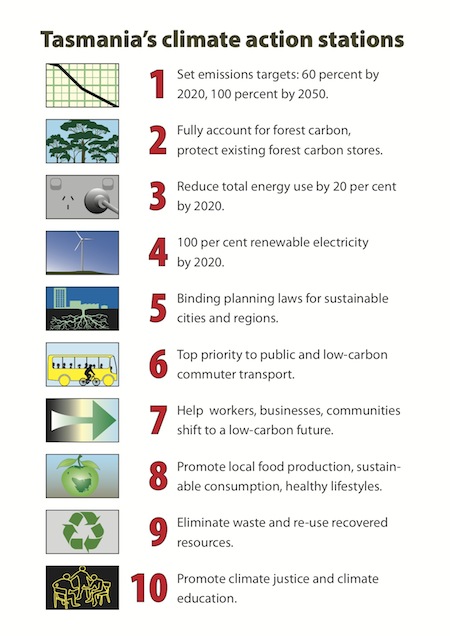Climate change seems to have missed a place on the Tasmanian election agenda. Now a campaign is under way to put it in its rightful place, at the top of Tasmania’s “to do” list. [19 January 2010 | Peter Boyer]
 Change is in the air. Big issues are swirling around us, calling for big decisions. Within two months Tasmanians will choose the people who will govern them until 2014. Could this turn out to be one of those rare events in Tasmanian politics, an election worth remembering?
Change is in the air. Big issues are swirling around us, calling for big decisions. Within two months Tasmanians will choose the people who will govern them until 2014. Could this turn out to be one of those rare events in Tasmanian politics, an election worth remembering?
We’ll almost certainly get plenty of campaign trivia, lost tempers and smeared reputations, and maybe a tight finish and frantic post-poll manoeuvring. But a better measure of success would be whether the election deals with the big issues and produces a capable, talented government.
Our chances don’t look good. The small size of Tasmania’s lower house allows parties to win no more than a dozen or so seats. Many of these will inevitably fall to party hacks being rewarded for loyal service, leaving little room for fresh, independent thinkers tackling big ideas. This is shaping as a humdrum election producing a humdrum parliament.
The biggest of the big issues, everywhere, is man-made climate change. We might have seen this as a national or international matter, but the double failure of the Copenhagen meeting and Australia’s emissions trading legislation has put new emphasis on what needs to be done at a sub-national level, like here in Tasmania.
Yet climate is not considered a significant Tasmanian campaign issue, rating far behind education, health, roads and pretty well anything else. It seems that the major parties believe climate action to be a matter for others, higher up the chain. But isn’t that where we’ve just failed?
What is it about climate and politicians? Do they find it too soft and blurry an issue to sell to the electors, unlike like a new road? Can’t they find the time, or sit still long enough, to get their heads around the science? Or do they not even bother to start, seeing it as some green conspiracy to deprive them of their hard-earned lifestyles?
Scientists have produced ample evidence of a crisis, including accelerating ice melting at both poles and an alarming carbon emissions trend. The political response is to postpone international action, quibble over national action (the federal opposition remains without a climate policy) and generally try to have the subject buried and forgotten.
In this age of the spectator we like to watch others stuff up while things collapse in a heap, but democracy doesn’t let us off that easily. We choose who governs us, so we’re partly culpable. Making our democracy work effectively means more than sitting back and watching.
Last week, a group called Climate Action Hobart launched a set of strategies intended to start parties and candidates thinking about where Tasmania should position itself on climate change — and then committing to a focused, sustained program of action.
The strategies, formulated with expert advice and fleshed out at a community forum late last year, call for action in ten key areas aimed at taking advantage of Tasmania’s resources, including renewable hydro energy, to make the state a leader in tackling climate change.
Now endorsed by local climate groups around the state, “10 steps to a safer climate” seeks the active engagement of political, community and business interests to contribute effectively to a safe climate while inspiring effective action elsewhere in the world.
The ambitious agenda aims to set Tasmania, without delay, on a path to zero carbon emissions by 2050, with a 2020 target for all-renewable energy and a 20 per cent reduction in overall energy use.
It advocates reformed planning laws for sustainable communities, support for public and low-carbon transport, support for local food and sustainable consumption, protection of old forests and rigorous carbon accounting, and the elimination of waste through a 100 per cent recycling program.
The plan asserts that most of the actions needed, while not cost-free, will bring great benefits, including more liveable, resilient communities with better housing, less pollution and less road congestion, more secure jobs, less vulnerability to global economic shocks and an increasingly valuable reputation as a haven for green tourism and sustainable development.
The program will be a demanding one. As the plan points out, “no-one can predict where the potholes will lie on the road ahead. We hope and expect this community plan to evolve and expand over time. Yet a journey of thousand miles begins with a single step.”
Over the next two months, climate groups across the state will join in publicity campaigns, candidate surveys and lobbying to impress upon political aspirants the over-riding importance of climate policy and the real, measurable value to Tasmania of taking world-leading initiatives.
Entering this election campaign, we can choose to put our trust in shaky initiatives elsewhere, higher up, over which we have no real authority. Or we can decide that climate is a significant public issue for Tasmania, and then stand up and work to make this place an example for others.
• Find further details about Ten steps to a safer climate at 10 Tasmanian strategies, or at Climate Action Hobart.

Pingback: launceston campus